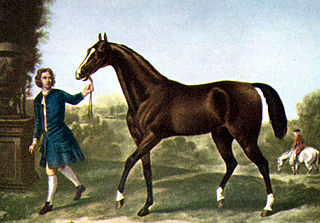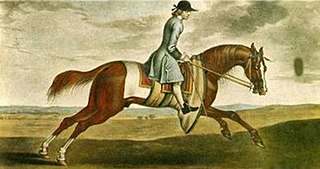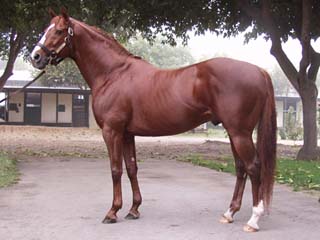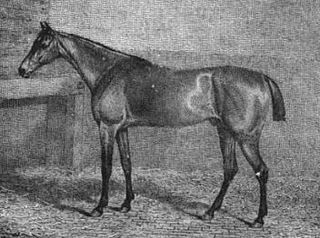Related Research Articles

The Darley Arabian was one of three dominant foundation sires of modern Thoroughbred horse racing bloodstock. The other two founders were the Godolphin Arabian and the Byerley Turk. This bay Arabian horse was bought in Aleppo, Syria, by Thomas Darley in 1704 and shipped to Aldby Park in England, as a present for his brother.

The Byerley Turk, also spelled Byerly Turk, was the earliest of three stallions that were the founders of the modern Thoroughbred horse racing bloodstock.

The Godolphin Arabian, also known as the Godolphin Barb, was an Arabian horse who was one of three stallions that founded the modern Thoroughbred. He was named after his best-known owner, Francis Godolphin, 2nd Earl of Godolphin.

Eclipse was an undefeated 18th-century British Thoroughbred racehorse who won 18 races, including 11 King's Plates. He raced before the introduction of the British Classic Races, at a time when four-mile heat racing was the norm. He was considered the greatest racehorse of his time and the expression, "Eclipse first, the rest nowhere" entered the English vernacular as an expression of dominance.
Sassafras was a champion racehorse.

The title of champion, or leading, sire of racehorses in Great Britain and Ireland is awarded to the stallion whose offspring have won the most prize money in Britain and Ireland during the flat racing season. The current (2022) champion is Dubawi, who earned his first title after finishing runner-up multiple times.

Flying Childers (1715–1741) was a famous undefeated 18th-century thoroughbred racehorse, foaled in 1714 at Carr House, Warmsworth, Doncaster, and is sometimes considered as the first truly great racehorse in the history of thoroughbreds and the first to catch the public imagination.

Matchem, sometimes styled as Match 'em, was a Thoroughbred racehorse who had a great influence on the breed, and was the earliest of three 18th century stallions that produced the Thoroughbred sire-lines of today, in addition to Eclipse and Herod. He was the Leading sire in Great Britain and Ireland from 1772 - 1774.

Cade (1734–1756) was an important foundation sire of Thoroughbred racehorses. He was the Leading sire in Great Britain and Ireland in 1752, 1753, 1758, 1759 and 1760.

Herod was a Thoroughbred racehorse. He was one of the three foundation sires of the modern Thoroughbred racehorse, along with Matchem and Eclipse. Herod was the foundation sire responsible for keeping the Byerley Turk sire-line alive.

Partner was a British Thoroughbred racehorse and sire. He won six of his seven races before being retired to stud where he was the Leading sire in Great Britain and Ireland four times, and continued the Byerley Turk sire-line.

Regulus (1739) was an undefeated British Thoroughbred racehorse who won eight Royal Plates in 1745.

Highflyer was an undefeated Thoroughbred racehorse and a very successful sire of the 18th century.

Marske was a Thoroughbred racehorse, best known as siring the great Eclipse.

The Thoroughbred is a horse breed developed for horse racing. Although the word thoroughbred is sometimes used to refer to any breed of purebred horse, it technically refers only to the Thoroughbred breed. Thoroughbreds are considered "hot-blooded" horses that are known for their agility, speed, and spirit.

Blucher was a British Thoroughbred racehorse and sire named after the Prussian General Gebhard Leberecht von Blücher, one of the most successful commanders of the Napoleonic Wars, but his name was invariably spelt without the umlaut.
Bartlett's Childers was an important Thoroughbred sire in the 18th century.

Bay Bolton or Brown Lusty (1705–1736) was a British Thoroughbred racehorse who won Queen Anne's Gold Cup as a five-year-old in 1710. After retiring from racing he became a successful sire for the Charles Paulet, 2nd Duke of Bolton, and his son Charles Powlett, 3rd Duke of Bolton, was Champion sire seven times.
Spilletta was a British Thoroughbred racehorse. She only raced once and is best known for being the dam of the undefeated Eclipse.
Spanker, sometimes called Old Spanker or the Pelham Arabian, was a British Thoroughbred racehorse who sired many important horses in the history of the breed. He was said to be the best horse in Newmarket, the home of British racing, during the reign of Charles II.